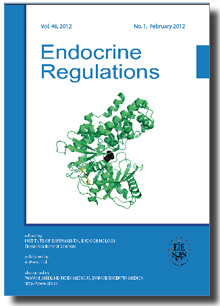Journal info
|
||
Select Journal
Journals
Bratislava Medical Journal Endocrine Regulations 2015 2014 2013 2012 2011 2010 2009 2008 2007 2006 2005 2004 2003 General Physiology and Biophysics Neoplasma Acta Virologica Studia Psychologica Cardiology Letters Psychológia a patopsych. dieťaťa Kovove Materialy-Metallic Materials Slovenská hudbaWebshop Cart
Your Cart is currently empty.
Info: Your browser does not accept cookies. To put products into your cart and purchase them you need to enable cookies.
Endocrine Regulations Vol.47, No.1, p.27–32, 2013 |
||
| Title: Association of nonalcoholic fatty liver disease (NAFLD) with urolithiasis | ||
| Author: B. Einollahi, M. R. Naghii, M. Sepandi | ||
| Abstract: Objective. The NAFLD is related to metabolic disorders and is negatively associated with kidney function. Renal stone disease (urolithiasis) is an increasing form of a common renal disease that is a multifactorial disorder influenced by both intrinsic and extrinsic, mainly environmental factors. The association between the fatty liver and renal calculi, as a specific underlying risk factor, has received no attention, so far. Therefore, in this study, a possible relationship between fatty liver with renal calculi and urolithiasis is investigated. Methods. In a cross sectional study, a total of 11245 ultrasonography reports revealing the condition of fatty liver, kidney stones (urolithiasis), or a combination of both of them, were categorized and evaluated statistically. Descriptive statistics determined the number (frequency and percentage) of each condition. The statistical significance of the association between fatty liver and kidney stone, and vice versa, was evaluated using McNemar’s test. The Chi Square Test assessed the relationship between genders. Odds ratios and 95% confidence intervals (95% CI) assessed the likelihood of characteristics of urolithiasis for fatty liver patients. Results. We found 8% frequency of urolithiasis among subjects with healthy liver. NAFLD was identified in 30%, while urolithiasis in 11% subjects from all individuals studied. The present study diagnosed urolithiasis in 17% of patients with fatty liver. Its occurrence was more common in men than women. Data revealed more common diagnosis of fatty liver (48%) in patients with urolithiasis, which was also higher in males than females. The higher NAFLD was linked with urolithiasis, indicating a greater chance of their association. Interestingly, the detection frequency of urolithiasis in the patients with NAFLD was also markedly higher (odds ratio: 2.4, 95% CI 2.1-2.7). The NAFLD appears to be an independent variable as a risk factor for stone formation. Conclusions. The present study indicates that the prevalence of urolithiasis is significantly higher in the NAFLD than healthy subjects. This result suggests that NAFLD may be involved in the mechanism of the onset of the urolithiasis. It is suggested that lipid peroxidation, oxidative stress and changes in the urinary constituents in the NAFLD may be considered as a risk factor in the progression of stone formations. |
||
| Keywords: nonalcoholic fatty liver disease, urolithiasis, association | ||
| Year: 2013, Volume: 47, Issue: 1 | Page From: 27, Page To: 32 | |
| doi:10.4149/endo_2013_01_27 |
||
|
Price:
12.00 €
|
||
|
|
||

